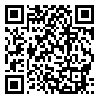Volume 4, Issue 1 (2-2019)
RSJ 2019, 4(1): 48-57 |
Back to browse issues page
Abstract: (2182 Views)
Background and Objectives: Lice infection as a social issue is one of the common health problems among students. Therefore, the aim of this study was to determine the effect of education based on Health Belief Model (HBM) on preventive behaviors of head lice infestation in students.
Materials and Methods: This was a semi-experimental interventional study. The study population consisted of 138 students (69 in each intervention and control group) in the sixth grade of primary school in Marivan city in 2017, that were selected by two-stage cluster sampling. Educational intervention was presented at 5 sessions. The data gathering tool was a demographic and Background questionnaire and a researcher-made questionnaire based on HBM and knowledge and Preventive behavior of Pediculosis, which completed in two stages before and two months after the intervention. The collected data were analyzed using SPSS software version 16 and proportional tests.
Results: There was no significant difference between demographic and Background variables between the two groups before intervention (P>0.05). Two months after the intervention, there was a significant difference between the mean scores of the knowledge and the perceived susceptibility and perceived barriers in the intervention group (P<0.05), but in other constructs of the HBM, as well as behavior, were not significantly different, before and after the intervention (P>0.05).
Conclusion: Despite the significant increase in knowledge and Perceived susceptibility and perceived barriers structures, the educational intervention did not have a significant effect on the adoption of preventive behaviors of head lice infestation.
Materials and Methods: This was a semi-experimental interventional study. The study population consisted of 138 students (69 in each intervention and control group) in the sixth grade of primary school in Marivan city in 2017, that were selected by two-stage cluster sampling. Educational intervention was presented at 5 sessions. The data gathering tool was a demographic and Background questionnaire and a researcher-made questionnaire based on HBM and knowledge and Preventive behavior of Pediculosis, which completed in two stages before and two months after the intervention. The collected data were analyzed using SPSS software version 16 and proportional tests.
Results: There was no significant difference between demographic and Background variables between the two groups before intervention (P>0.05). Two months after the intervention, there was a significant difference between the mean scores of the knowledge and the perceived susceptibility and perceived barriers in the intervention group (P<0.05), but in other constructs of the HBM, as well as behavior, were not significantly different, before and after the intervention (P>0.05).
Conclusion: Despite the significant increase in knowledge and Perceived susceptibility and perceived barriers structures, the educational intervention did not have a significant effect on the adoption of preventive behaviors of head lice infestation.
Type of Study: Research |
Subject:
Special
Received: 2019/04/14 | Accepted: 2019/06/29 | Published: 2019/02/15
Received: 2019/04/14 | Accepted: 2019/06/29 | Published: 2019/02/15
| Rights and permissions | |
 |
This work is licensed under a Creative Commons Attribution-NonCommercial 4.0 International License. |
